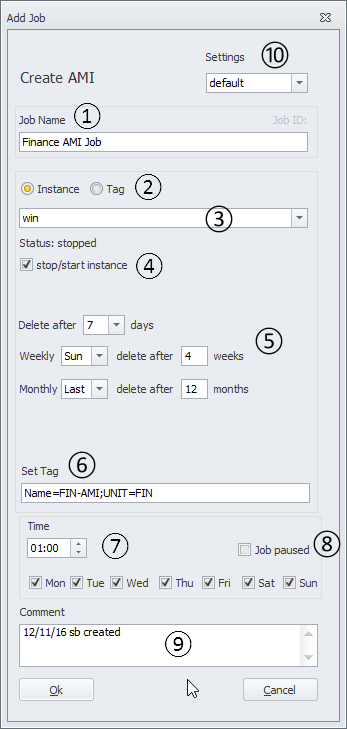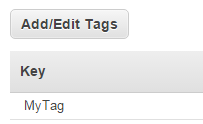To create an AMI of an EC2 instance you create a new “Create AMI” job by clicking the plus-sign on the toolbar.
Selecting Instance by Instance-ID
① The “Job Name” defines the name of a job. This name is shown in the job list, the job log and in mail notifications. Put a short description of the job in here.
② Select the “Instance” radio button to create an AMI by choosing the instance. All volumes of the selected instance are included in the AMI. Select the “Tag” radio button if you want to select the instance(s) up by entering a tag. We will explain this later.
③ Select the instance in the combo box.
④ If you check this box the instance will be stopped before creating the AMI and started afterwards. Stopping the instance will make sure that you get a consistent snapshot.
If you you do not stop your instance while creating an AMI you might end up with an AMI that can not be started.
⑤ You can define the retention period for your backups by selecting the number of days in the “Delete after x days” combo box. All snapshots that are older than the selected number of days will be deleted by the job. To achieve this AutomatiCloud tags all the snapshots it creates with a tag that has the unique JOBID of the Job in its key field. This JOBID is used for the deletion of snapshots that are older than the configured retention period.
AutomatiCloud will only delete snapshots that have a matching JOBID. It will never delete snapshots not created by itself.
The cleanup procedure is an integrated part of the snapshot job. This means that a weekly backup job will only look once a week for outdated snapshot and delete them when needed.
Creating AMI by TAG
③ Alternatively you can create a job that is creating AMIs of one or multiple instances that have a certain tag associated.
Select the “Tag” Radio button and enter the name of the tag in the “tag” field. Example “MyTag”
Open AWS Console and tag all the instances you want to back up with a key named “MyTag”.
You can tag one or many instances with the tag “MyTag”. AutomatiCloud will create AMIs for all of them.
⑥ After snapshot creation is finished AutomatiCloud can assign one or more tags to the AMI. The Key and Value of the tags can be controlled by filling out the “Set Tag” field.
You can add up to nine pairs of “key=value” separated by semicolon. Each “key=value” pair creates one tag. And you can use macros in your tag Definition that are expanded during Job execution.
Example:
“Name=AC Snapshot;Cust=Comtoso;SET=$DOW” will result in three tags:
- Tag 1: Key=Name, Value=AC Snapshot
- Tag 2: Key=Cust, Value=Comtoso
- Tag 3: Key=Set, Value=TUE (weekday of Job execution)
Available Macros:
- $DOW: Three letter day of week (MON)
- $DATE: Date (24.08.2015)
- $TIME: Time (22:00)
- $DAYOFWEEK: Day of week (Monday)
- $MOY: Month of year (JAN)
- $MONTHOFYEAR: Month of year (March)
- $MON: Month of year (03)
- $DOM: Day of month (24)
- $YEAR: Year (2015)
- $VOLID: Volume ID (vol-2343DEF)
Macros are case-sensitive. “$TIME” is valid “$Time” is invalid. All macros are expanded during job execution not job definition.
⑦ Now you can set up the schedule for your job. Tick the check box for every day you want to execute your job and enter the time to run.
⑧ The “Comment field” allows you to enter free text describing your job (date/time you created the job or last edit).
⑨ By ticking the “Pause” check box you can temporarily stop the execution of a job without deleting it.
⑩ The “Setting” combo box allows you to control under which set of parameters the job is executed. You will always have one “Default” setting. The Settings dialog allows you to create additional settings controlling AWS credentials, region and notification parameters.


